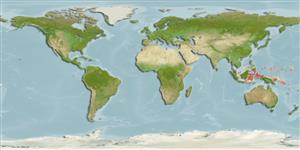>
Blenniiformes (Blennies) >
Blenniidae (Combtooth blennies) > Blenniinae
Etymology: Petroscirtes: Latin, petra, -ae = stone + Greek, skirteo = to jump.
More on author: Bleeker.
Environment: milieu / climate zone / depth range / distribution range
Ecologia
marino demersale; distribuzione batimetrica 1 - 5 m (Ref. 90102). Tropical; 10°N - 12°S
Western Central Pacific: Moluccas, New Guinea, Solomon Islands; Belau and Yap in Micronesia.
Size / Peso / Age
Maturity: Lm ? range ? - ? cm
Max length : 5.9 cm SL maschio/sesso non determinato; (Ref. 1602)
Short description
Chiavi di identificazione | Morfologia | Morfometria
Spine dorsali (totale) : 10 - 11; Raggi dorsali molli (totale) : 16 - 18. Closely related to P. variabilis, but is usually more elongate and has a bulbous or elongate snout.
Adults inhabit weedy areas such as Sargassum beds. They occur in shallow seagrass beds where they hide by pressing itself against a blade of seagrass. Oviparous. Eggs are demersal and adhesive (Ref. 205), and are attached to the substrate via a filamentous, adhesive pad or pedestal (Ref. 94114). Larvae are planktonic, often found in shallow, coastal waters (Ref. 94114).
Life cycle and mating behavior
Maturities | Riproduzione | Spawnings | Egg(s) | Fecundities | Larve
Oviparous, distinct pairing (Ref. 205).
Myers, R.F., 1991. Micronesian reef fishes. Second Ed. Coral Graphics, Barrigada, Guam. 298 p. (Ref. 1602)
IUCN Red List Status (Ref. 130435)
Threat to humans
Harmless
Human uses
Strumenti
Special reports
Download XML
Fonti Internet
Estimates based on models
Preferred temperature (Ref.
123201): 28.5 - 29.4, mean 28.9 °C (based on 585 cells).
Phylogenetic diversity index (Ref.
82804): PD
50 = 0.5005 [Uniqueness, from 0.5 = low to 2.0 = high].
Bayesian length-weight: a=0.01122 (0.00514 - 0.02450), b=3.04 (2.87 - 3.21), in cm total length, based on all LWR estimates for this body shape (Ref.
93245).
Trophic level (Ref.
69278): 2.4 ±0.3 se; based on size and trophs of closest relatives
Resilienza (Ref.
120179): Alto, tempo minimo di raddoppiamento della popolazione meno di 15 mesi (Preliminary K or Fecundity.).
Fishing Vulnerability (Ref.
59153): Low vulnerability (10 of 100).
